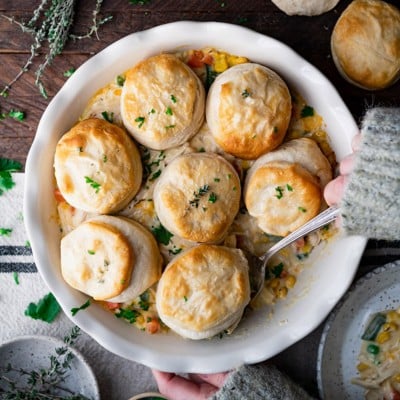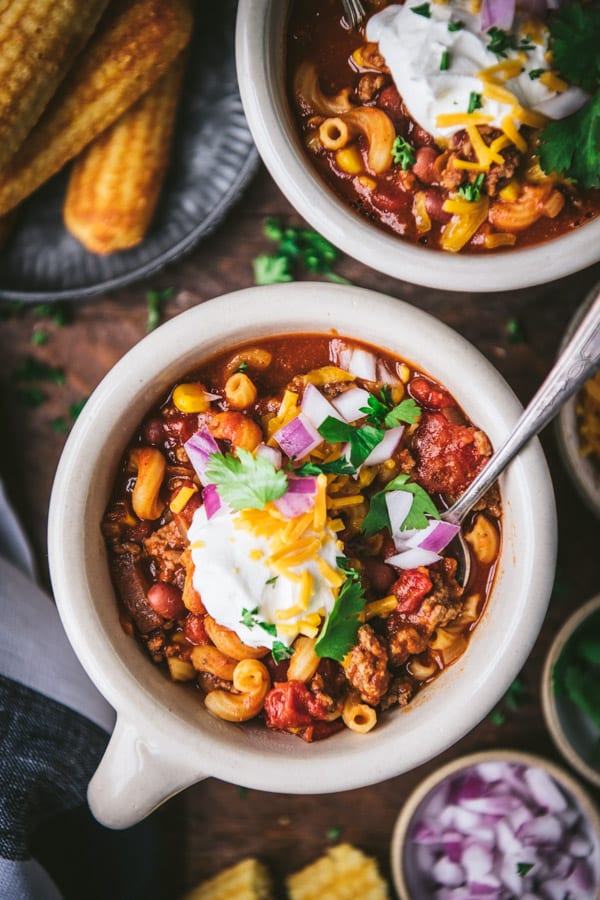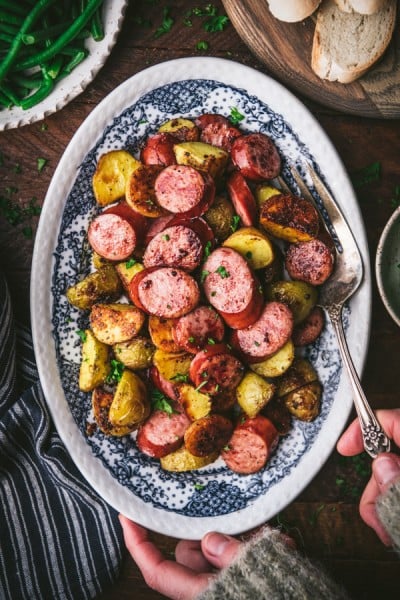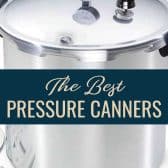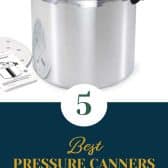Disclosure: This post may contain affiliate links. I may earn a small commission for my endorsement, recommendation, testimonial, and/or link to any products or services from this website.
The best pressure canners offer a simple and convenient way to make foods last so you can stock your shelves up with those extra veggies from your garden! Preserving food with a pressure canner is the safest way to preserve low-acid foods such as fresh vegetables, meats, and beans for long periods.
Although it can be intimidating at first, Blair explains that “pressure canning is not too much different than hot water bath canning, with one exception: You have to keep a close eye on the canner the entire time so that you can adjust the heat to keep the pressure consistent.”

Table of Contents
Blair and I investigated all of the top sellers, and looked at customer reviews, website ratings, Reddit threads and canning forums, and analysis from culinary experts to bring you best pressure canners currently on the market, including the one she uses in her own kitchen, the Presto 23-quart Pressure Canner. Presto stands out because of its quality and price, and Blair appreciates how easy it is to use for someone getting started in canning. That said, we also found All American canners to be extremely durable, although they are more costly.
Ahead, read our picks for the best pressure canners, along with some tips on how (and when) to safely use them.
Our Top Picks:
- In Blair’s Kitchen: Presto Pressure Canner & Cooker (23 Quart) – $139.56 at Walmart
- Best Large Pressure Canner: All American Pressure Canner (25 Quarts) $431.72 at Walmart
- Best Budget Pressure Canner: T-fal Pressure Canner (22 Quart) – $109.99 at Amazon
- Best Pressure Canner for Beginners: Presto Aluminum Canner (16 Quart) – $132.99 at Walmart
- Best Electric Pressure Canner: Presto Electric Pressure Canner (12 Quart) – $290.18 at Amazon
Reviews of The Best Pressure Canners
1. In Blair’s Kitchen: Presto Pressure Canner & Cooker (23 Quart)

Blair uses the Presto 23-quart Pressure canner on her gas stovetop, which has earned high marks from other culinary publications as well.
“It’s really simple to operate!” Blair explains. “The manual that comes with the canner has very specific instructions, and the pressure is easy to maintain by adjusting the heat on my stovetop.” The canner also includes a canning rack so you can double stack the jars to hold 20 pints, 7 quarts, or 26 half-pint jars.
Its fast and even heating makes it excellent for pressure-canning low-acid foods like poultry, meats, and seafood. However, it can also be used to preserve high-acid foods such as jams and preserves, pickles, salsa, and fruits through the boiled water canning method. Since it’s made from heavy-gauge aluminum, it won’t warp after long-term use (a common issue with less-durable products). The canned also comes with an extended 12-year limited warranty – which is the same for all of the Presto canners.
The Specs:
Capacity: 23 quarts
Size: 15.1 x 15.4 x 14.8 inches
Weight: 12 pounds
Warranty: Extended 12-year limited
The Pros:
- Large capacity
- Durable
- Can be used on electric, gas, and smooth-top ranges
- Comes with a recipe and instruction guide
The Cons:
- Requires regular calibration testing
- Not compatible with induction stovetops
- Not recommended for gas ranges exceeding 12,000 BTUs
What Others Are Saying
The 23-Quart Presto Pressure Canner was voted the best overall pressure canner by Treehugger and Simply Recipes. This product also has a 4.8 rating on Amazon from over 16,900 reviews.
Buy the Presto 23-Quart Pressure Canner & Cooker:
2. Best Large Pressure Canner: All American Pressure Canner (25 Quarts)

All American is another top brand that manufactures pressure canners in 6 different size options ranging from 10.5 to 41 quarts. Made in the U.S. by a family owned company that’s been in business since 1930, these seriously heavy-duty canners are very popular among the homesteading community, but are a more expensive option.
They’re made of cast aluminum so they’re build to last, and they have dial pressure gauges built into the lids and weighted control regulators, plus durable wingnuts to secure the lid in place during use. If you plan on doing a lot of canning, this could be a great option for you. The 25 quart capacity can hold up to 19 regular-mouth pint jars (or 16 wide-mouth pints).
The Specs:
- Capacity: 25 quarts (but even larger sizes are available)
- Size: 16.75 inches (height) 12.25 inches (diameter)
- Weight: 18.25 pounds
- Warranty: One year
Pros:
- Large capacity canner
- Durable construction
- Compatible with gas, electric, and flat-top stoves
- Built in regulators and gauges for less maintenance
Cons:
- Different color options are only available in 21.5 quart size
- Pricey
- Heavy
What Others Are Saying:
Serious Eats found the smaller, 10.5 quart All American pressure canner to be the best pressure canner they tested. The Spruce Eats also reviewed and tested the smaller model and found it to be “the top of its class.” Reddit users liked the versatility of the All American pressure canners.
Buy the All American Pressure Canner (25 Quart):
3. Best Budget Pressure Canner: T-fal Pressure Canner (22 Quart)
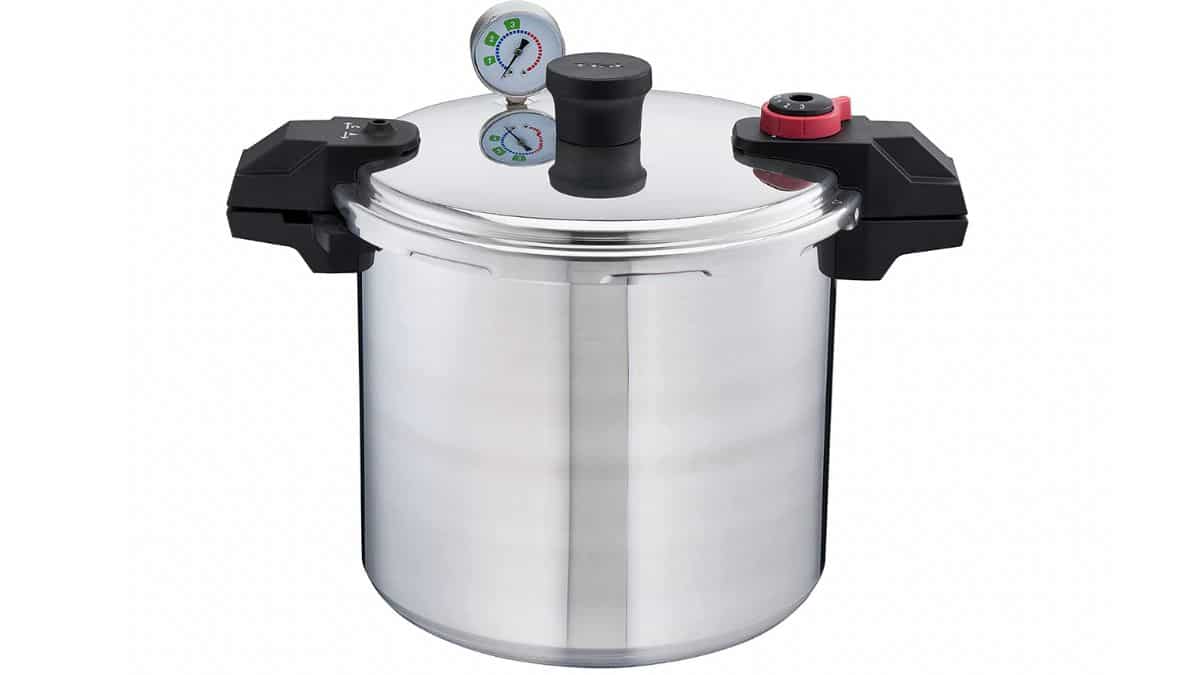
If you’re canning on a budget, the T-fal is very reasonably priced compared to similar products, but still earns top marks from customers. It also has a fairly large capacity that can hold 16-pint jars, 7 quart-size jars, or 26 half-pint jars (if you double stack them).
Made from rust-resistant aluminum, the T-fal pressure canner is also specifically designed with safe canning in mind, with loads of added safety features like an automatic steam release if the canner becomes overpressure. There’s also a safety spring that prevents the pressurization of the cooker before being securely closed, and a sure-locking lid system ensures it can’t be opened when the cooker is pressurized.
The Specs:
Capacity: 22 quarts
Size: 15.39 x 19.33 x 16.26 inches
Weight: 14.77 pounds
Warranty: 10-year
The Pros:
- Budget-friendly
- Compatible with gas and electric stovetops
- Comes with two racks for stacking
- Tons of safety features
The Cons:
- Not compatible with induction stovetops
- Dial can be a little challenging to read
What Others Are Saying
The T-fal Pressure Canner rated best for safety by All Recipes and rated best large canner by Treehugger. The T-fal has a 4.6-star rating from more than 10,900 reviews on Amazon.
Buy the T-fal Pressure Canner (22 Quart):
4. Best for Beginners: Presto Aluminum Canner (16 Quart)
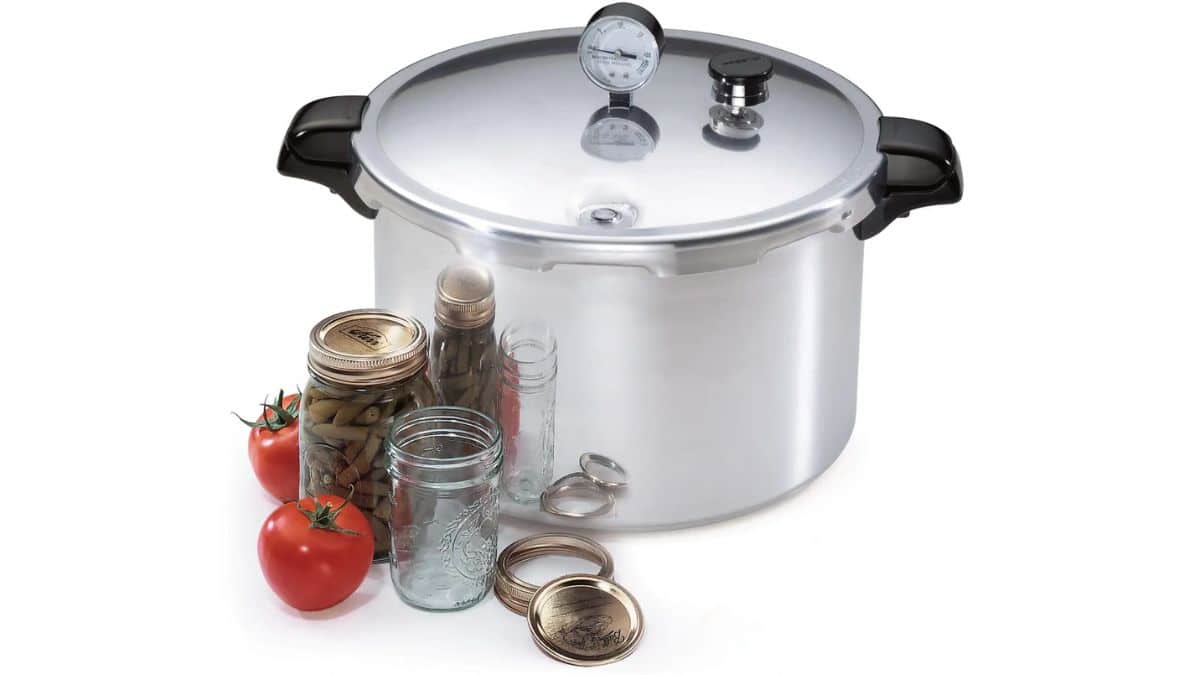
Another Presto top-rated pressure canner is the 16-quart model, which is an excellent stove-top pressure canner for beginners due to its smaller size and ease of use. Its smaller capacity is for anyone who wants to start out with canning a few items at a time, helping to avoid feeling overwhelmed. It’s also easier to store!
This canner is made from heavy gauge aluminum and works on gas, electric, and smooth-top stoves. It can hold up to 7 quart-size jars when pressure canning, but it can also be used for water bath canning if you’re preserving jams and other fruit spreads.
The Specs:
Capacity: 16 quarts
Size: 13.62 by 17.31 by 11.8 inches
Weight: 10.5 pounds
Warranty: Extended 12-year limited warranty
The Pros:
- Easy to use
- Affordable
- Easy to clean
- Smaller for storage
The Cons:
- Only holds quart jars
- Requires monitoring to keep constant pressure
- Not compatible with induction stovetops
What Others Are Saying
Simple Recipes named the 16-Quart Presto Aluminum Canner the best for pressure canner beginners, and the Spruce Eats and All Recipes found it to be the best overall pressure canner they tested. It also has an Amazon rating of 4.8 stars from more than 3,200 reviews.
Buy the Presto Aluminum Canner (16 Quart):
5. Best Electric: Presto Electric Pressure Canner (12 Quart)
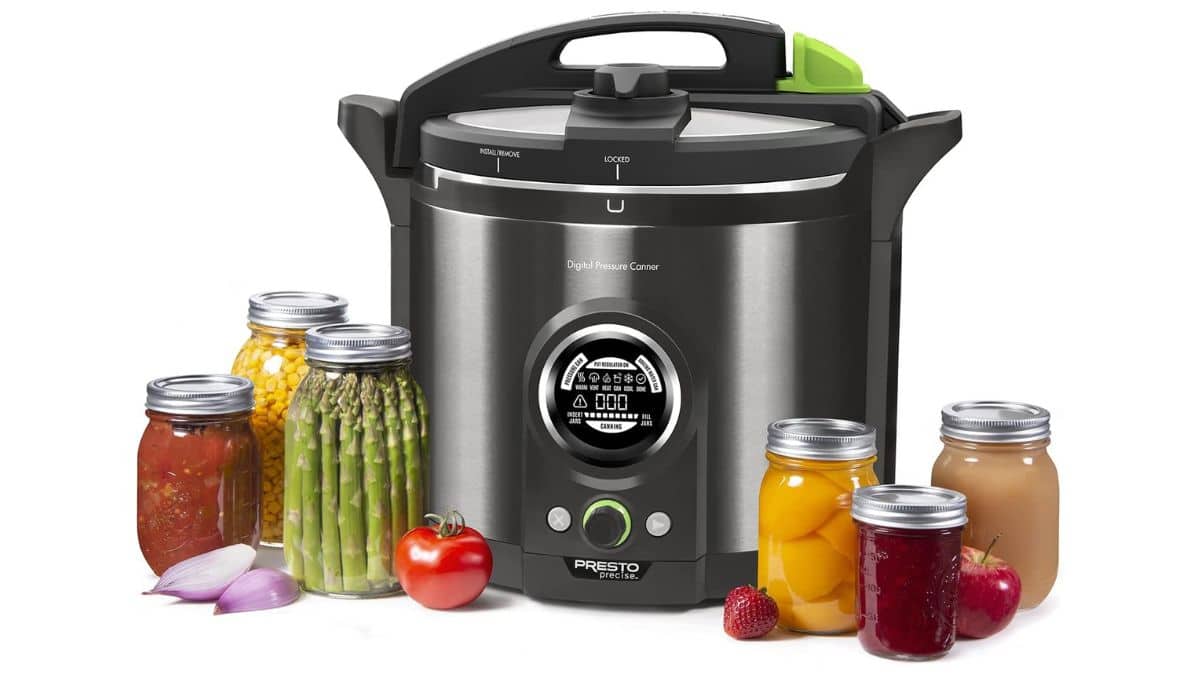
This digital pressure canner is a trailblazer because it’s designed to allow pressure canning without a stove – you just plug it directly into an outlet. The device does all the hard work for you by managing the correct pressure and temperature with internal sensors to maintain the heat at the precise temperature. Its LED display makes this canner seamless to use, but with only a 12-quart capacity, it’s best for smaller batches.
That said, electric pressure canners are not yet endorsed by the USDA as a safe method to cook low-acid foods. However, Presto stands by this electric canner, stating that “it meets USDA home canning guidelines for safely processing meats, poultry, fish, vegetables, and other low acid foods.” The company ensures it’s the first of its kind to meet the standards based on internal testing, but this does not mean it’s USDA-approved because the USDA does not verify specific products. Noting this, you must follow the directions provided by Presto to ensure proper use.
The Specs:
Capacity: 12 quarts
Size: 14 x 17 x 16 inches
Weight: 20.5 pounds
Warranty: Extended 12-year limited warranty
The Pros:
- Easy to use
- Automated pressure and temperature control
- Easy-to-read LED display icons
The Cons:
- Expensive
- Small capacity
- Electric canning not yet been verified safe by USDA
What Others Are Saying
The Presto 12 Quart Canner was voted the best digital pressure canner by Treehugger, and Simply Recipes. The Spruce Eats also awarded it best digital out of all the pressure canners they tested. It also has a 4.7-star rating on Amazon from more than 2,400 reviews.
Buy the Presto 12 Quart Digital Pressure Canner:
Other Pressure Canners to Consider
Mirro Pressure Canner (22 Quarts)
If you’re looking for a large-capacity canner that isn’t too pricey, the Mirro 22 Quart Pressure Canner is a solid option. It includes two racks allowing it to hold 7 quart-sized jars, 18 pint-sized jars (stacked) or 24 half-pint jars, and a beautiful stainless stell finish. Plus, despite it’s larger size, it’s not too heavy. However, it’s not compatible with flat-top cooking surfaces and doesn’t work well at high altitudes. The Mirro 22 Quart Pressure Canner is available at Amazon from $111.93.
Presto Induction Compatible Pressure Canner
This model is almost identical to Blair’s top pick (the standard 23-quart Presto Canner) except it has a stainless steel clad base, so it can be used on an induction stovetop (although it may not work on all portable induction ranges). That said, the rack rates are a little higher than our top choice, so unless you specifically need a pressure canner for an induction stove or can snag this induction canner when it’s on sale, you can save a few bucks with the original model. The Presto Induction Compatible Pressure Canner is available at Amazon for $147.99.
Zavor EZLock Stove-top Pressure Canner (12.7 Quarts)
Zavor has been making pressure canners for over 25 years and now has 5 different sizes available for pressure cooking, but the 12.7-quart size with an 11-inch wide diameter is large enough that it’s suitable for pressure canning as well. The canner includes two pressure settings (10 PSI or 15 PSI) and a knob to control them, but isn’t compatible with pressure gauges, a common device with pressure canners. For the price, we thought some of the others offered a better experience. The Zavor EZLock 12.7 Quart Stovetop Pressure Canner is available at Amazon for $219.95.
Barton Pressure Canner 22 Quart
This polished aluminum pressure canner is made by Barton Living, a company that makes a variety of home products (but doesn’t specialize in kitchen items). It’s budget-friendly compared to other brands and remains of good quality, but we found that it isn’t as user-friendly and spare parts can be difficult to come by. The Barton 22-Quart Pressure Canner is available at Walmart for $99.95.
Why You Can Trust Us
I’m Georgina Caro, an award-winning content creator, eco-living expert, and certified vegetarian and vegan nutritionist. During my writing career, I have researched and written a variety of different product guides to enable my readers to make more informed purchases. I’ve been featured in numerous home and lifestyle publications, including Apartment Therapy, Huffpost, House Beautiful, Ethical Consumer, Impakter, and many more.

Blair Lonergan, the founder of The Seasoned Mom, a busy home cook and freelance recipe developer, shows her love by cooking delicious meals for her friends and family. She shares her Virginia-inspired recipes on her website in the hope her readers will get inspired and create loving, home-cooked meals of their own. If you’re interested in making your own jams, pickles, and preserves, check out Blair’s recipes for canning homemade fruit spreads and condiments.
Together, Blair and I created a list of the best pressure canners on the market by compiling the most popular brands for pressure canners and leveraging her own experience with pressure canning. We then took a deep dive into product reviews and ratings, and compared specifications of each product, including the design, the type of pressure gauge, the cost, and ease of use.
What to Know About Pressure Canners
What is a Pressure Canner?
A pressure canner is a large pot with a lid that locks into place that’s used for preserving low-acid foods such as chicken, beef, certain fruits, beans, and vegetables. They also typically include a dial or weighted gauge on top that regulates steam pressure within the pot.
When boiling water through conventional methods, water temps can reach 212°F, however, a pressure canner heats jars filled with low-acid foods up to 250°F. This effectively kills microorganisms so that they can be stored for long periods of time, and is the only safe method recommended by the USDA for canning low-acid foods.
If you’re canning high-acids, like jams and preserves, you might be interested in our list of the best water bath canners!
How Big of a Pressure Canner Should You Buy?
How much canning do you plan on doing? If you have a farmhouse and plan to stock up for your family and friends and neighbors, go with something larger like 25 quarts or more. If you have a small garden and just want to preserve a few veggies, a smaller 16 quart sizes should do the trick. The “average” size is about 23 quarts, and most of these pressure canners can fit 7 quart size jars and 20 pint size jars.
Is a Pressure Canner the Same as a Pressure Cooker?
A pressure canner is not the same as a pressure cooker (although some large models are marketed to perform both functions). Pressure cookers are smaller and are designed to cook foods under pressure in a short amount of time compared to using a regular pot or oven. They can be used to cook a variety of foods including pot roast, pulled pork, rice, chicken dinners, and other meals intended to be consumed shortly afterward. That said, most pressure cookers should not be used as a pressure canner unless they’re large enough and specifically designed to do so.
On the other hand, pressure canners are designed to extend the food item’s longevity. They’re used to kill harmful microorganisms in low-acid foods such as soups, stews, meat, vegetables, and some sauces so they can be safely stored and consumed at a later date.

How to Use a Pressure Canner?
Before canning low-acid foods, it’s important to read the instruction manual for your specific pressure canner and follow the steps as directed to ensure safe operation. However, to give you an idea of what’s involved, here are some general directions for using a pressure canner. For more specific information, you can also check out the USDA’s recommended guidelines for home canning.
- Prepare the pressure canner. Unlike a boiling water canner (where you submerge the jars), you only need to fill the pressure canner with about 2-3 inches of water.
- Fill the glass mason jars and remove any air bubbles using a silicone spatula. Wipe any spill from the jar rim and add your lids.
- Fill your canner with the jars and lock the lid.
- Allow the canner to vent for 10 minutes. When the pressure regulator starts to move, adjust the heat to create a steady rattling sound.
- Set the timer for your recipe. When the time is up, turn off the heat.
- Do not open the lid until the safety valve drops or the dial returns to zero.
- Remove the pressure regulator and take off the lid, away from your face to avoid steam burns.
- Allow the jars to cool inside the canner for a good 10 minutes.
- Remove the jars from the canner and place on a cooling rack. Allow them to cool for 12-24 hours.
- Store the jars in a cool dark place and use the food within a year.
What Makes a Good Pressure Canner?
Pressure canners come in a variety of different sizes but according to the USDA, it must be large enough to hold at least four quart-size jars (but many are much larger than that). The size pressure canner you need will depend on how much food you plan to preserve on a regular basis.
A good pressure canner should have the following features: a lockable lid, a removable ventilated rack, a steam vent, an automatic cover lock and a pressure gauge. There are two main types of gauges: a dial-gauge which tells you what the pressure is and a weighted gauge that also has the ability to adjust the pressure.

Are Pressure Canners Necessary?
Pressure canners are a simple but effective way to preserve your food for longer. They are designed specifically for the purpose of removing harmful microorganisms in canned food in a safe way. If you are canning low-acid foods like vegetables, seafood, chicken, and other meats, you will need a pressure canner. However, if you are canning high-acidity foods like fruit jams and pickles, you can use the water bath canning method instead. Most pressure canners have the ability to perform both canning methods, just don’t lock the lid down when using it for water bath canning (or the pressure can build up).
Blair often prepares pickles, jams, and jellies without a pressure canner in a large pot on the stove using her deepest stockpot, a sterilized funnel, and sterilized mason jars. For jams, she prefers to use half-pint jars. “It’s just the right amount of jam to keep in the fridge after it’s opened, but smaller 4-ounce jars are also a great option,” says Blair. If you use the boiling water option, she also recommends canning tongs because they’re incredibly helpful when taking the jars in and out of the boiling water.
If you’re new to canning, you may want to consider starting off with the water bath method for high-acid foods to see if you enjoy canning (or do it frequently enough) before investing in a pressure canner for low-acid foods.
Can You Use an Instant Pot for Canning?
No, you cannot use an Instant Pot as a pressure canner, because this preservation method requires the food in the pot to be kept at a specific pressure to eliminate bacteria. This is not possible to achieve with an Instant Pot.
However, some models of the Instant Pot allow for boiling-water canning, which can be used for jams and pickles, but pressure canning is the only method recommended safe by the USDA for low-acid foods.
The Best Canning Recipes
Here are some of Blair’s favorite recipes for water bath canning, a method you can do in a pressure canner (but again, don’t lock the lid like you would when pressure canning).
Prices were accurate at the time of publication.

